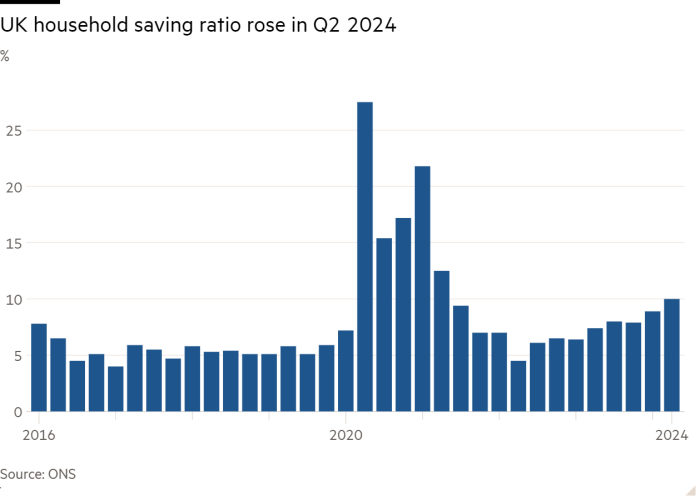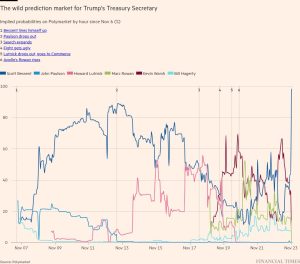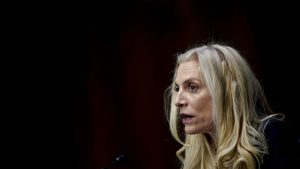UK economic growth revised lower as households saved more

Unlock the Editor’s Digest for free
Roula Khalaf, Editor of the FT, selects her favourite stories in this weekly newsletter.
The UK economy grew more slowly than estimated in the second quarter as the households savings rate climbed to the highest since 2021, underlining the challenge facing Sir Keir Starmer’s government.
UK gross domestic product grew 0.5 per cent in the three months to June, the Office for National Statistics said on Monday, down from its first estimate of 0.6 per cent and slower than the 0.7 per cent expansion in the first quarter.
The second quarter was marked by a jump in the household saving ratio — the proportion of disposable income that households save — to 10 per cent, up from 8.9 per cent in the first three months of the year and the highest since the second quarter of 2021.
The increase suggests that caution from households held back consumer spending, which rose 0.2 per cent in the quarter. Households’ real disposable income grew by 1.3 per cent in the period, down from 1.6 per cent in the previous three months, ONS data showed.
Economists said the revisions showed growth had slowed in the second quarter from a faster pace at the start of the year, when the economy rebounded from a technical recession in 2023. Separate figures published earlier this year showed the economy failed to grow in both June and July.

Starmer has pledged to kick-start the economy, targeting long-term growth of 2.5 per cent, and boost living standards. However, the government has warned that difficult decisions will be required to fix what it has characterised as a £22bn black hole in the public finances. Chancellor Rachel Reeves will deliver her first budget on October 30.
The revisions from the ONS come after the Bank of England this month held interest rates at 5 per cent but signalled it may cut borrowing costs again as soon as November.
“The recent rebound in activity from the mild recession has been a bit softer,” said Paul Dales, economist at the consultancy Capital Economics.
According to the ONS revisions, the UK economy expanded 0.3 per cent last year, up from an initial estimate of 0.1 per cent. The change, along with previous revisions to 2022 data, means the economy was 2.9 per cent larger at the end of the second quarter than it was in the final three months of 2019, before the coronavirus pandemic.

For 2022, the ONS revised the household savings ratio down, which helped drive stronger economic growth in the period, but the rate is up from the low it hit during that year.
The revisions showed that household consumption volumes in the second quarter were 1 per cent higher than pre-pandemic levels, compared with an initial estimate that they were 1.5 per cent lower.
“This changes the economic story post-Covid slightly, with consumers funding the growth rebound in 2022 by dipping into their savings accumulated during Covid more than previously thought,” said Rob Wood, economist at the consultancy Pantheon Macroeconomics.
In the second quarter, the savings ratio climbed as households only spent part of their increase in disposable incomes. Economists said that growth could yet receive a boost if households dip into their savings in coming months, a point made by BoE rate setter Megan Green last week.
“While the prospect of higher taxes in the Budget on October 30 are one downside risk to consumer spending, a fall in the saving rate is an upside,” said Dales.
Jeremy Hunt, shadow chancellor, insisted the revised figures still showed that the economy bequeathed to the Labour government was stronger than Starmer claimed.
“Today’s figures once again discredit Labour’s fabricated narrative on the economy,” said Hunt, who is attending the Tory conference in Birmingham. “With the Budget only one month away, she must not use it to further damage business confidence with higher regulation and higher taxes.”
#economic #growth #revised #households #saved







